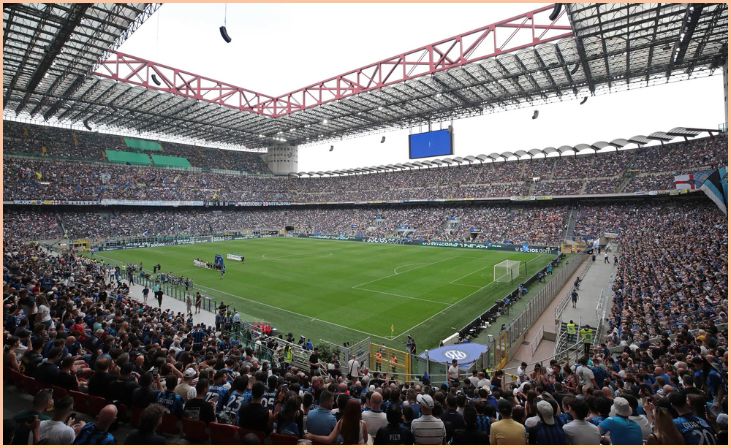Biggest European Stadiums – In the vibrant tapestry of European sports culture, stadiums stand as colossal monuments to the passion and fervor that define the continent’s athletic heritage. These colossal structures not only bear witness to historic clashes but also serve as cultural touchstones, embodying the collective spirit of nations.
In this exploration, we delve into the colossal arenas that encapsulate the grandeur of European sports. From the iconic Camp Nou in Barcelona, Spain, to the historic Wembley Stadium in London, England, each venue tells a story of triumph, heartbreak, and the enduring power of athletic spectacle.
Join us as we traverse the vast landscapes of these monumental structures, each echoing with the cheers and roars of devoted fans, creating a mosaic of memories etched into the very foundations of Europe’s sporting legacy.
Biggest European Stadiums
Camp Nou (Barcelona, Spain)

Camp Nou, located in Barcelona, Spain, is one of Europe’s largest stadiums with an approximate seating capacity of 99,354. Home to FC Barcelona, it stands as an iconic football venue. The stadium, officially named the Nou Camp, has been witness to numerous historic football moments and events.
Renowned for its passionate atmosphere, it showcases the fervent support of the Barça fans. Camp Nou underwent renovations over the years to enhance facilities and maintain its status as a premier football arena. The stadium not only represents the sporting spirit of Barcelona but also stands as a symbol of football excellence and Catalan pride.
Wembley Stadium (London, England)
Wembley Stadium, situated in London, England, is an iconic sports and entertainment venue with a seating capacity of 90,000. Renowned as the “Home of Football,” it hosts major events, including football matches, concerts, and more.
The stadium, featuring its distinctive arch, stands on the historic site of the original Wembley Stadium. It has been the backdrop to numerous historic moments in English football, including memorable cup finals and international matches.
Wembley is equipped with state-of-the-art facilities and technology, offering a world-class experience for both athletes and spectators. As a symbol of sporting excellence, it continues to be a centerpiece for grand events and celebrations.
Also, Read – Largest Stadiums in Australia
Signal Iduna Park (Westfalenstadion) (Dortmund, Germany)
Signal Iduna Park, also known as Westfalenstadion, is a football stadium in Dortmund, Germany, renowned for its passionate atmosphere and the fervent support of Borussia Dortmund fans. With a seating capacity of 81,365, it stands as the largest stadium in Germany.
The famous “Yellow Wall” is a standout feature, comprising the South Stand and creating an electric ambiance during matches.
Signal Iduna Park has witnessed numerous historic football moments, hosting domestic and international competitions. The stadium’s modern design, coupled with the enthusiasm of the supporters, makes it a formidable fortress for Borussia Dortmund, contributing to the rich football culture of the region.
Old Trafford (Manchester, England)
Old Trafford, situated in Manchester, England, is the iconic home ground of Manchester United Football Club. With a seating capacity of 74,140, it stands as one of the largest stadiums in the United Kingdom.
Fondly known as the “Theatre of Dreams,” Old Trafford has been witness to decades of football history, hosting legendary matches and unforgettable moments.
The stadium’s rich heritage is reflected in its classic design and the famous Stretford End, where passionate fans create a spirited atmosphere. Old Trafford remains a symbol of Manchester United’s success and is a must-visit for football enthusiasts seeking to immerse themselves in the club’s storied legacy.
San Siro (Giuseppe Meazza) (Milan, Italy)

San Siro, officially named Stadio Giuseppe Meazza, is a legendary football stadium located in Milan, Italy. Hosting both A.C. Milan and Inter Milan, it stands as one of Europe’s iconic football arenas. With a capacity of 75,923, the stadium is named after legendary Italian player Giuseppe Meazza.
San Siro has been a witness to countless historic moments, including domestic and international football triumphs. Its distinctive architecture and atmosphere make it a symbol of Milanese football culture.
Renovations over the years have modernized the facilities while preserving the stadium’s rich legacy, creating an enduring home for the passionate football supporters of both Milan clubs.
Also, Read – The Origins of 10 Popular Sports
Stade de France (Saint-Denis, France)
Stade de France, located in Saint-Denis, France, is a prominent sports and entertainment stadium with a capacity of 81,338. As the national stadium of France, it holds a special place in sports history, having hosted major events like the 1998 FIFA World Cup final and the UEFA Euro 2016 championship.
The stadium’s distinctive architecture, highlighted by its towering roof, symbolizes modernity and innovation. Stade de France is not only a venue for football but also a stage for diverse events, including concerts and athletics. Its central role in French sports and culture makes it a significant and dynamic landmark in the heart of the country.
Santiago Bernabéu (Madrid, Spain)
Santiago Bernabéu, located in Madrid, Spain, stands as the iconic home of Real Madrid CF. With a seating capacity of 81,044, this historic stadium is named after the club’s former president, Santiago Bernabéu.
Renowned for its electrifying atmosphere, it has witnessed numerous football triumphs and hosted major events, including European Cup finals. The stadium underwent renovations to enhance its facilities and modernize its design, ensuring it remains at the forefront of football venues.
The Santiago Bernabéu not only serves as a fortress for Real Madrid but also symbolizes the club’s rich history and enduring legacy in the realm of Spanish and European football.
Allianz Arena (Munich, Germany)
Allianz Arena, situated in Munich, Germany, is a cutting-edge football stadium and the home of FC Bayern Munich. With a capacity of 75,000, its most distinctive feature is the illuminated façade, capable of displaying various colors.
This dynamic lighting system transforms the stadium into a captivating spectacle during matches. Allianz Arena has been the stage for historic moments in German football and international competitions. As one of Europe’s modern stadiums, it offers state-of-the-art facilities and a vibrant atmosphere.
The iconic architecture and technological innovations make Allianz Arena a symbol of sporting excellence and a must-visit for football enthusiasts in Munich.
Stadio Olimpico (Rome, Italy)
Stadio Olimpico, nestled in Rome, Italy, is a historic sports venue with a capacity of 72,698. Serving as the home for both A.S. Roma and S.S. Lazio, it holds a unique position as the only stadium in the world to host the FIFA World Cup final (1990) and the UEFA European Championship final (1968).
The stadium’s classic architecture and the picturesque backdrop of the Tiber River contribute to its timeless appeal. Stadio Olimpico is a stage for intense football rivalries and has witnessed unforgettable moments in Italian and international football, solidifying its status as an enduring symbol of the sport in the heart of Rome.
Parc des Princes (Paris, France)

Parc des Princes, located in Paris, France, is a historic football stadium and the home of Paris Saint-Germain (PSG). With a seating capacity of 48,712, it stands as one of the iconic venues in French football.
The stadium has undergone renovations over the years, combining modern amenities with its classic architecture. Parc des Princes has hosted memorable football matches and significant sporting events, adding to its rich legacy.
As the stronghold of PSG, the stadium resonates with the passionate support of fans. Its central location in Paris and its role in French football history make Parc des Princes a symbol of sporting excellence in the capital.
Conclusion
In the grand symphony of European sports, these colossal stadiums serve as enduring temples of athletic prowess and shared experiences. From the historic Wembley to the iconic Camp Nou, each venue weaves a tapestry of moments that resonate across time.
As these architectural giants continue to host the triumphs and trials of sports, they stand not just as structures of concrete and steel but as living monuments to the unifying power of competition. In their shadows, the echoes of cheers and the footprints of legends remind us that, in the heart of Europe’s stadiums, the spirit of sportsmanship reverberates eternally.
FAQs
Camp Nou has a seating capacity of over 99,000, making it one of the most massive football stadiums globally.
Wembley Stadium in London, England, is one of the largest stadiums in Europe, known for hosting major football events and concerts.
Wembley Stadium has a seating capacity of around 90,000, making it the second-largest stadium in Europe.






